Attached files
| file | filename |
|---|---|
| 8-K - 8-K - W R GRACE & CO | gra8-kx090914keybanc.htm |

1 © 2014 W. R. Grace & Co. Hudson La Force Senior Vice President & Chief Financial Officer Strong Performance - Disciplined Investment W. R. Grace & Co. KeyBanc Basic Materials & Packaging Conference September 9, 2014

2 © 2014 W. R. Grace & Co. Disclaimer Safe Harbor Statement under the Private Securities Litigation Reform Act of 1995 This presentation contains forward-looking statements, that is, information related to future, not past, events. Such statements generally include the words “believes,” “plans,” “intends,” “targets,” “will,” “expects,” “suggests,” “anticipates,” “outlook,” “continues” or similar expressions. Forward-looking statements include, without limitation, expected financial positions; results of operations; cash flows; financing plans; business strategy; operating plans; capital and other expenditures; competitive positions; growth opportunities for existing products; benefits from new technology and cost reduction initiatives, plans and objectives; and markets for securities. For these statements, Grace claims the protection of the safe harbor for forward-looking statements contained in the Private Securities Litigation Reform Act of 1995. Like other businesses, Grace is subject to risks and uncertainties that could cause its actual results to differ materially from its projections or that could cause other forward-looking statements to prove incorrect. Factors that could cause actual results to materially differ from those contained in the forward-looking statements include, without limitation: risks related to foreign operations, especially in emerging regions, the cost and availability of raw materials and energy, the effectiveness of its research and development and growth investments, acquisitions and divestitures of assets and gains and losses from dispositions, developments affecting Grace's funded and unfunded pension obligations, its legal and environmental proceedings, costs of compliance with environmental regulation and those additional factors set forth in Grace's most recent Annual Report on Form 10-K, quarterly report on Form 10-Q and current reports on Form 8-K, which have been filed with the Securities and Exchange Commission and are readily available on the Internet at www.sec.gov. Reported results should not be considered as an indication of future performance. Readers are cautioned not to place undue reliance on Grace's projections and forward-looking statements, which speak only as the date thereof. Grace undertakes no obligation to publicly release any revision to the projections and forward-looking statements contained in this announcement, or to update them to reflect events or circumstances occurring after the date of this announcement. Non-GAAP Financial Terms These slides contain certain “non-GAAP financial terms” which are defined in Appendix I. Reconciliations of non-GAAP terms to the closest GAAP term (i.e., net income) are provided in Appendix II.
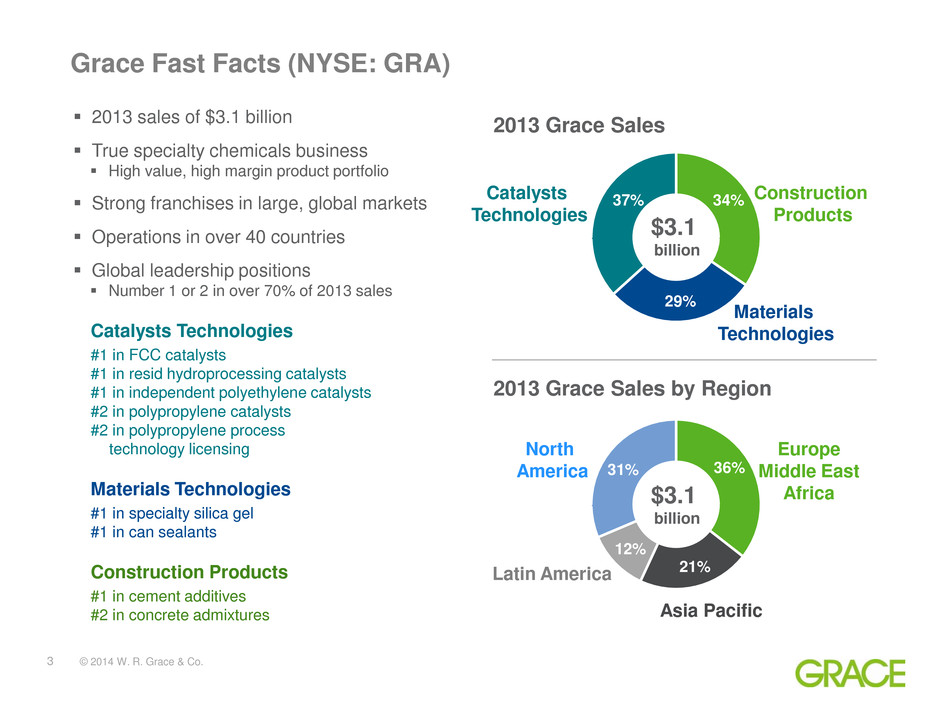
3 © 2014 W. R. Grace & Co. 36% 21% 12% 31% 34% 29% 37% Grace Fast Facts (NYSE: GRA) 2013 sales of $3.1 billion True specialty chemicals business High value, high margin product portfolio Strong franchises in large, global markets Operations in over 40 countries Global leadership positions Number 1 or 2 in over 70% of 2013 sales Catalysts Technologies #1 in FCC catalysts #1 in resid hydroprocessing catalysts #1 in independent polyethylene catalysts #2 in polypropylene catalysts #2 in polypropylene process technology licensing Materials Technologies #1 in specialty silica gel #1 in can sealants Construction Products #1 in cement additives #2 in concrete admixtures 2013 Grace Sales 2013 Grace Sales by Region $3.1 billion $3.1 billion Catalysts Technologies Construction Products Materials Technologies North America Europe Middle East Africa Asia Pacific Latin America

4 © 2014 W. R. Grace & Co. Core Competencies Core Competencies Drive Our Growth and Returns on Invested Capital Grow core franchises in big, global markets Differentiate products at the customer level Build capabilities in emerging markets Drive productivity by reducing complexity and cost of poor quality (COPQ) Strategies Invest our cash flow to drive growth and returns Capital Allocation
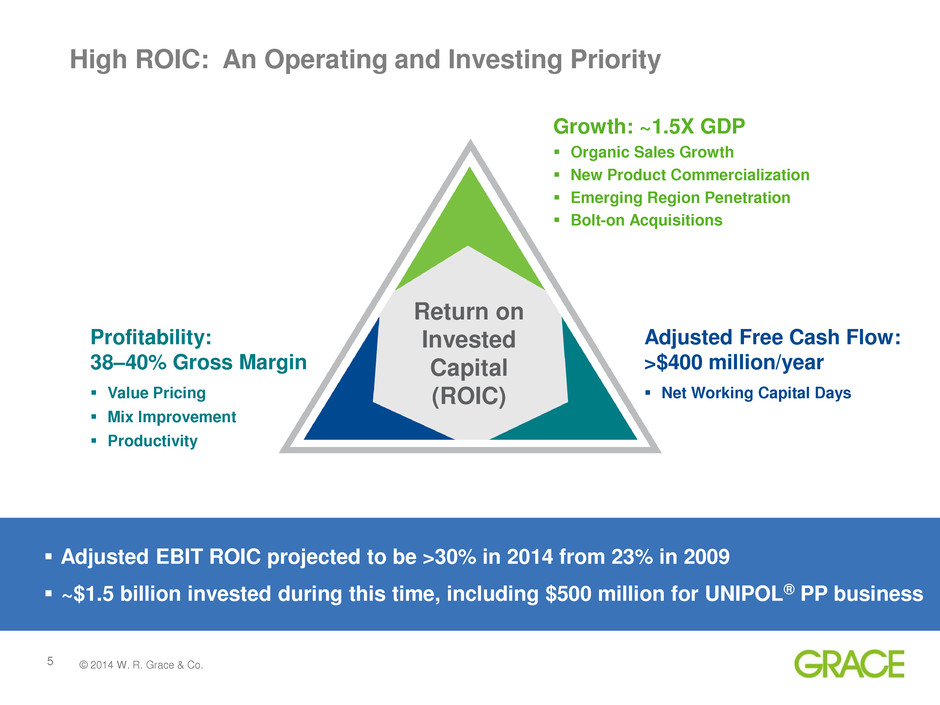
5 © 2014 W. R. Grace & Co. Adjusted EBIT ROIC projected to be >30% in 2014 from 23% in 2009 ~$1.5 billion invested during this time, including $500 million for UNIPOL® PP business High ROIC: An Operating and Investing Priority Growth: ~1.5X GDP Organic Sales Growth New Product Commercialization Emerging Region Penetration Bolt-on Acquisitions Adjusted Free Cash Flow: >$400 million/year Net Working Capital Days Profitability: 38–40% Gross Margin Value Pricing Mix Improvement Productivity Return on Invested Capital (ROIC)

6 © 2014 W. R. Grace & Co. Net Sales ($MM) Adjusted Free Cash Flow ($MM) Adjusted EBIT ROIC 23.3% 29.8% 37.7% 38.9% 27.4% >30% 0% 10% 20% 30% 40% 2009 2010 2011 2012 2013 2014O 397 246 278 421 430 >400 $0 $100 $200 $300 $400 $500 2009 2010 2011 2012 2013 2014O Segment Gross Margin Adjusted EBITDA ($MM) 379 478 633 677 674 780- 760 13.4% 17.9% 19.7% 21.5% 22.0% ~23% 0% 5% 10% 15% 20% 25% $0 $200 $400 $600 $800 2009 2010 2011 2012 2013 2014O Adjusted EBITDA Margin Note 1: 2014 Outlook as of July 23, 2014 Note 2: Net sales excludes ART JV deconsolidated in December 2009 and rare earth surcharges of $280 million, $110 million and $15 million in 2011, 2012 and 2013, respectively. Solid Financial Performance 2590 2675 2932 3046 3046 ~3300 34.1% 35.3% 36.2% 37.0% 37.1% ~38% 0% 10% 20% 30% 40% $0 $1,000 $2,000 $3,000 $4,000 2009 2010 2011 2012 2013 2014O
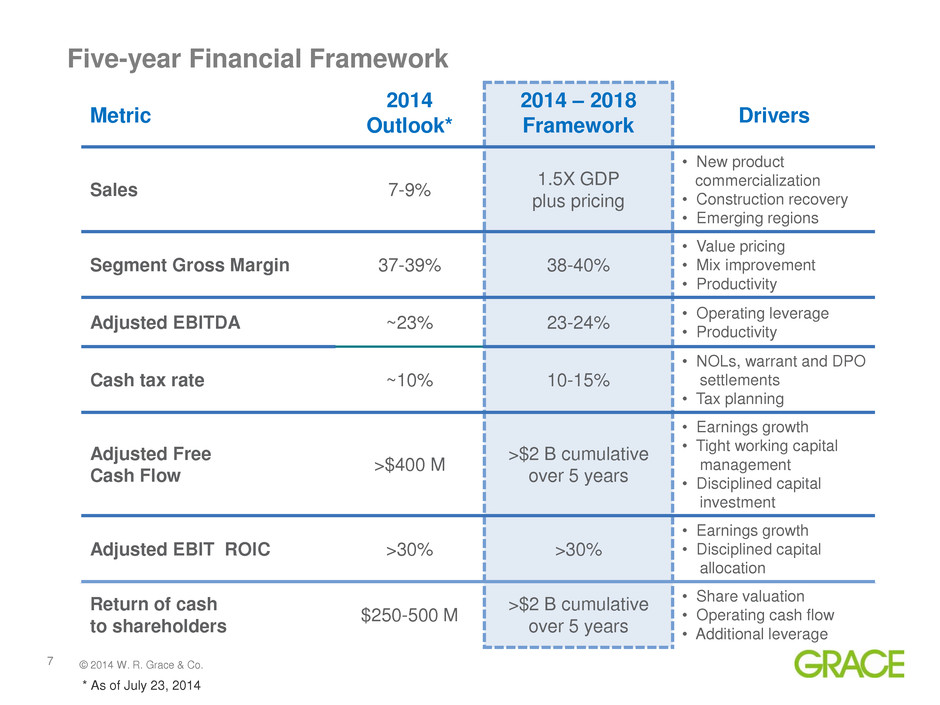
7 © 2014 W. R. Grace & Co. Five-year Financial Framework Metric 2014 Outlook* 2014 – 2018 Framework Drivers Sales 7-9% 1.5X GDP plus pricing • New product commercialization • Construction recovery • Emerging regions Segment Gross Margin 37-39% 38-40% • Value pricing • Mix improvement • Productivity Adjusted EBITDA ~23% 23-24% • Operating leverage • Productivity Cash tax rate ~10% 10-15% • NOLs, warrant and DPO settlements • Tax planning Adjusted Free Cash Flow >$400 M >$2 B cumulative over 5 years • Earnings growth • Tight working capital management • Disciplined capital investment Adjusted EBIT ROIC >30% >30% • Earnings growth • Disciplined capital allocation Return of cash to shareholders $250-500 M >$2 B cumulative over 5 years • Share valuation • Operating cash flow • Additional leverage * As of July 23, 2014
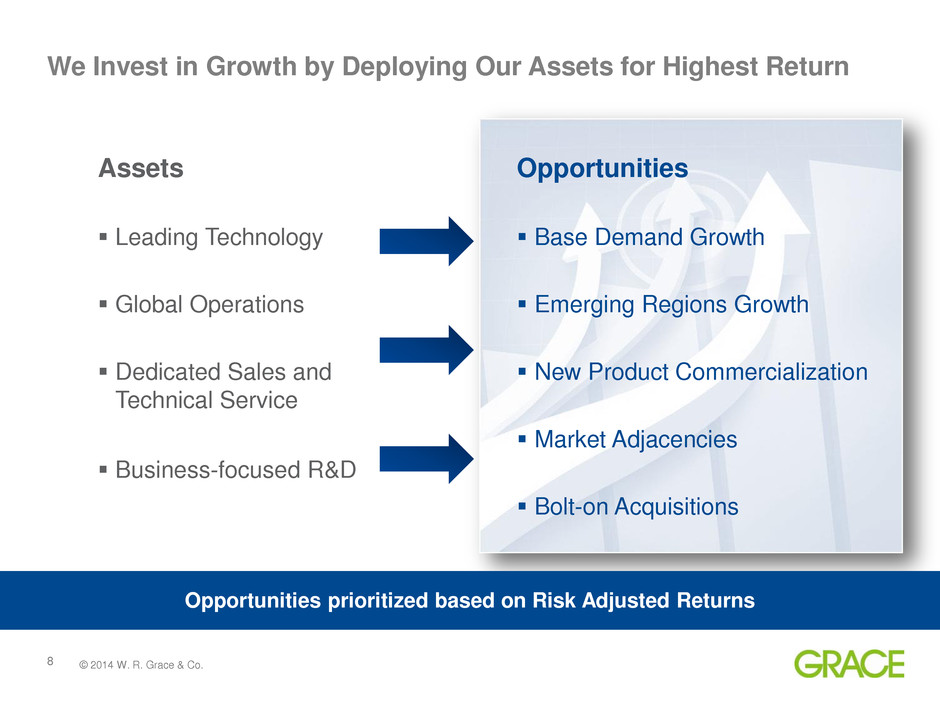
8 © 2014 W. R. Grace & Co. We Invest in Growth by Deploying Our Assets for Highest Return Opportunities Base Demand Growth Emerging Regions Growth New Product Commercialization Market Adjacencies Bolt-on Acquisitions Assets Leading Technology Global Operations Dedicated Sales and Technical Service Business-focused R&D Opportunities prioritized based on Risk Adjusted Returns

9 © 2014 W. R. Grace & Co. Focused Growth Programs Annual Growth Opportunity Risk Return FCC / Refinery Catalysts – Invest to maintain #1 position 3-4% Hydroprocessing Catalysts – Invest to improve position 6-8% Polyolefins – Catalysts and Licensing 6-8% Discovery Sciences >10% Waterproofing / Specialty Building Materials technologies 6-8% New Product Incubation – Adjacent markets and / or technologies >10% Internal Investment Focused on Programs with Higher than Average Margins and Growth High Medium

10 © 2014 W. R. Grace & Co. Margin Improvement Through Productivity and Mix Improve gross margins 300 bps in 5 years 34% 37% 40% 2009 2013 2018 Second wave productivity initiatives provide opportunities for additional margin expansion Improve Mix – 100 bps Refresh Products – 100 bps Drive Productivity – 100 bps Grow High Margin Businesses PE / PP catalysts PP licensing New FCC catalysts Discovery Sciences SBM specialties Product differentiation through technology to improve performance Re-formulate to deliver value Optimize manufacturing investments Reduce COQ / COPQ Use global process improvement
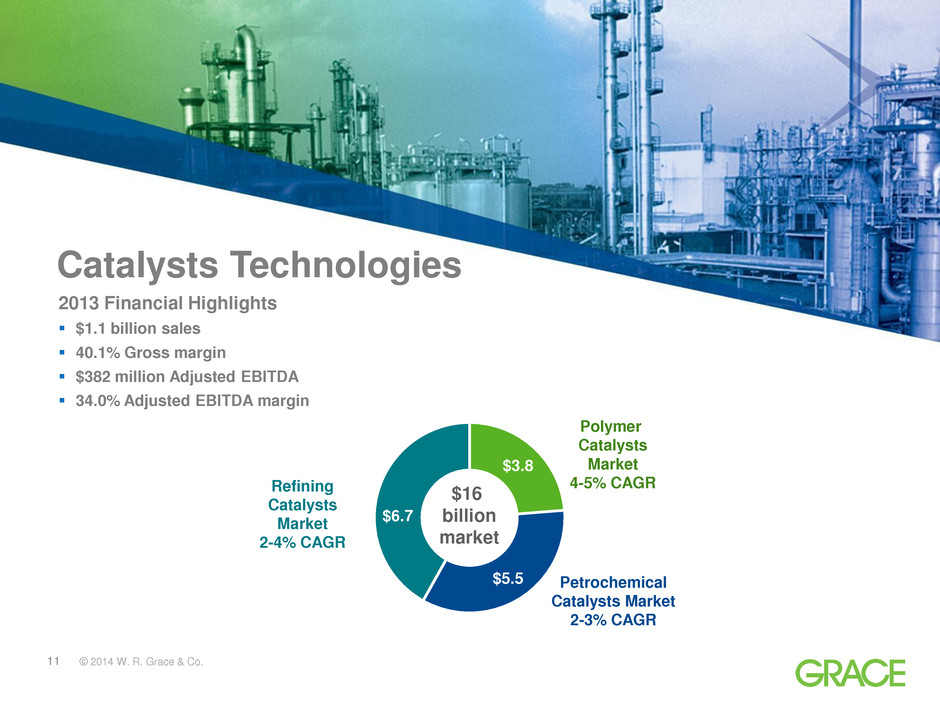
11 © 2014 W. R. Grace & Co. $3.8 $5.5 $6.7 Polymer Catalysts Market 4-5% CAGR Refining Catalysts Market 2-4% CAGR Catalysts Technologies © 2014 W. R. Grace & Co. Petrochemical Catalysts Market 2-3% CAGR $16 billion market 2013 Financial Highlights $1.1 billion sales 40.1% Gross margin $382 million Adjusted EBITDA 34.0% Adjusted EBITDA margin
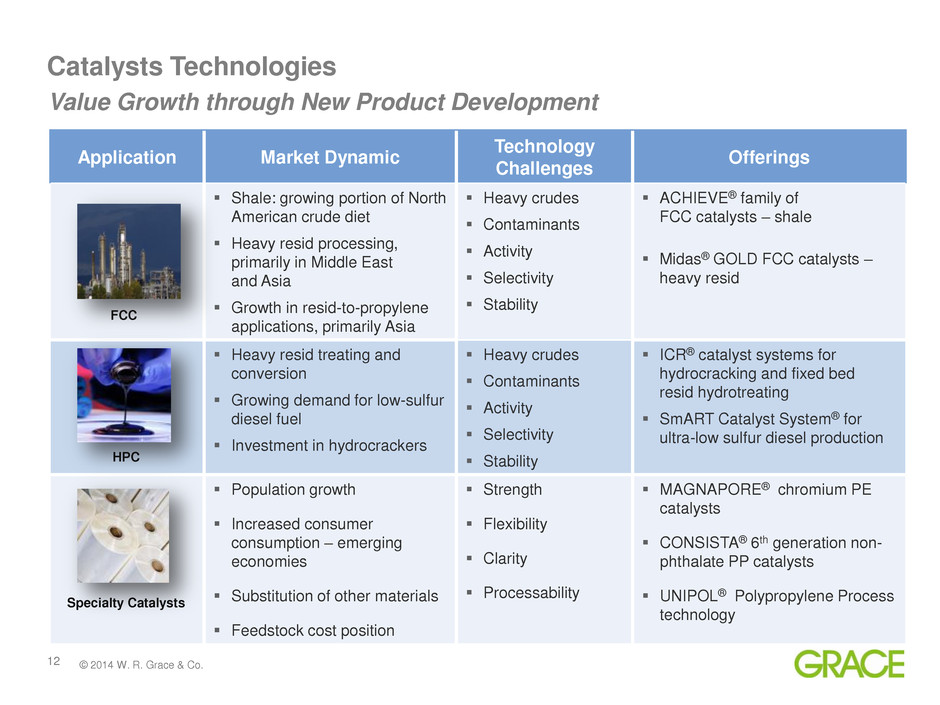
12 © 2014 W. R. Grace & Co. Catalysts Technologies Application Market Dynamic Technology Challenges Offerings Shale: growing portion of North American crude diet Heavy resid processing, primarily in Middle East and Asia Growth in resid-to-propylene applications, primarily Asia Heavy crudes Contaminants Activity Selectivity Stability ACHIEVE® family of FCC catalysts – shale Midas® GOLD FCC catalysts – heavy resid Heavy resid treating and conversion Growing demand for low-sulfur diesel fuel Investment in hydrocrackers Heavy crudes Contaminants Activity Selectivity Stability ICR® catalyst systems for hydrocracking and fixed bed resid hydrotreating SmART Catalyst System® for ultra-low sulfur diesel production Population growth Increased consumer consumption – emerging economies Substitution of other materials Feedstock cost position Strength Flexibility Clarity Processability MAGNAPORE® chromium PE catalysts CONSISTA® 6th generation non- phthalate PP catalysts UNIPOL® Polypropylene Process technology FCC HPC Specialty Catalysts Value Growth through New Product Development
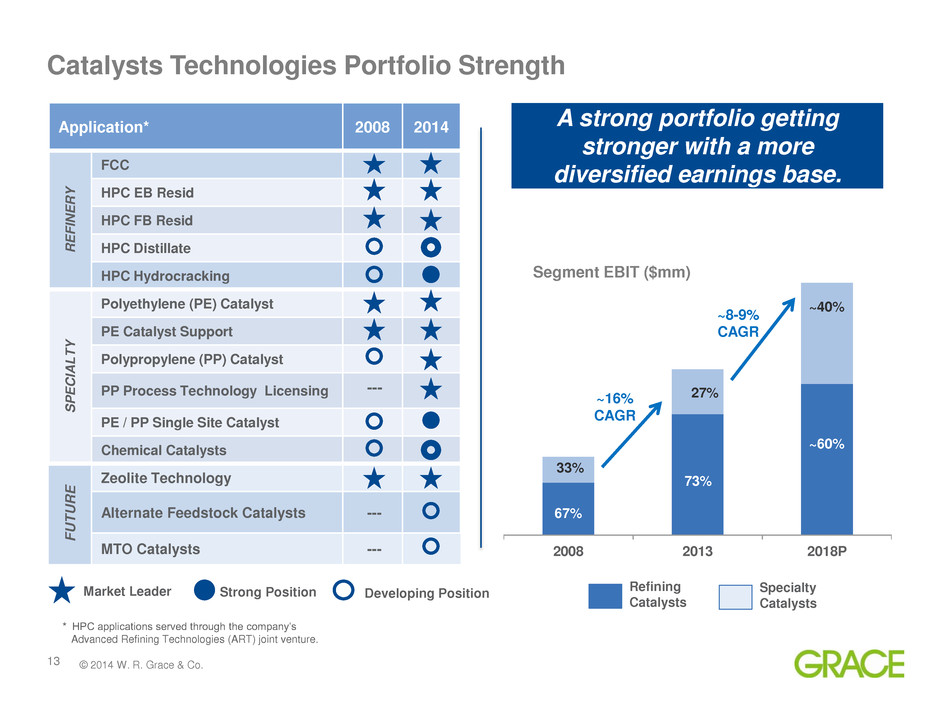
13 © 2014 W. R. Grace & Co. Catalysts Technologies Portfolio Strength Application* 2008 2014 R E F IN E R Y FCC HPC EB Resid HPC FB Resid HPC Distillate HPC Hydrocracking S P E CIA L T Y Polyethylene (PE) Catalyst PE Catalyst Support Polypropylene (PP) Catalyst PP Process Technology Licensing --- PE / PP Single Site Catalyst Chemical Catalysts F U T U R E Zeolite Technology Alternate Feedstock Catalysts --- MTO Catalysts --- Market Leader Developing Position Strong Position * HPC applications served through the company’s Advanced Refining Technologies (ART) joint venture. 2008 2013 2018P A strong portfolio getting stronger with a more diversified earnings base. Refining Catalysts Segment EBIT ($mm) 33% 67% 73% 27% ~40% ~60% Specialty Catalysts ~16% CAGR ~8-9% CAGR

14 © 2014 W. R. Grace & Co. Refining Catalysts – Volume Growth Through Increased Demand Demand for transportation fuel: Global demand for transportation fuels growing ~2-3% annually Refining capacity, crude slate, regulation: 60+ new FCC units planned through 2018, primarily resid focused Heavier feedstocks to grow ~5% annually, primarily in emerging regions Environmental regulation and legislation Demand for petrochemical feedstocks: Growth in emerging regions driving demand for propylene FCC units a primary source of propylene supply Change in complexity of feedstocks Demand growth driving tighter FCC supply conditions 0 10 20 30 40 50 60 70 2008 2015 2020 2025 OECD Non-OECD Quadrillion BTU Non-OECD demand to grow at higher rate Source: US Energy Information Agency, International Energy Outlook, September 2011 Demand for Transportation Fuels Developed (OECD) Developing (non - OECD) 3.5% CAGR

15 © 2014 W. R. Grace & Co. Example: UNIPOL® PP Acquisition Provided Leadership Position in PP Catalysts and Licensing Sources: Company estimates; Chemical Marketing Resources, Inc. Others 20% 9% 8% 21% 42% Grace LyondellBasell (Spheripol®) Lummus (Novolen®) Ineos (Innovene®) Polypropylene Catalysts PP demand growing >GDP PP process technology licensing creates catalyst market PP catalysts are: • Process specific • Impart polymer performance characteristics • Driver for polymer differentiation • Driver for process differentiation UNIPOL® PP Update Delivering cost and operational synergies Key personnel and know-how retained Seamless functional integration Strong cultural fit 2012 Polypropylene Catalyst Market $500 million market
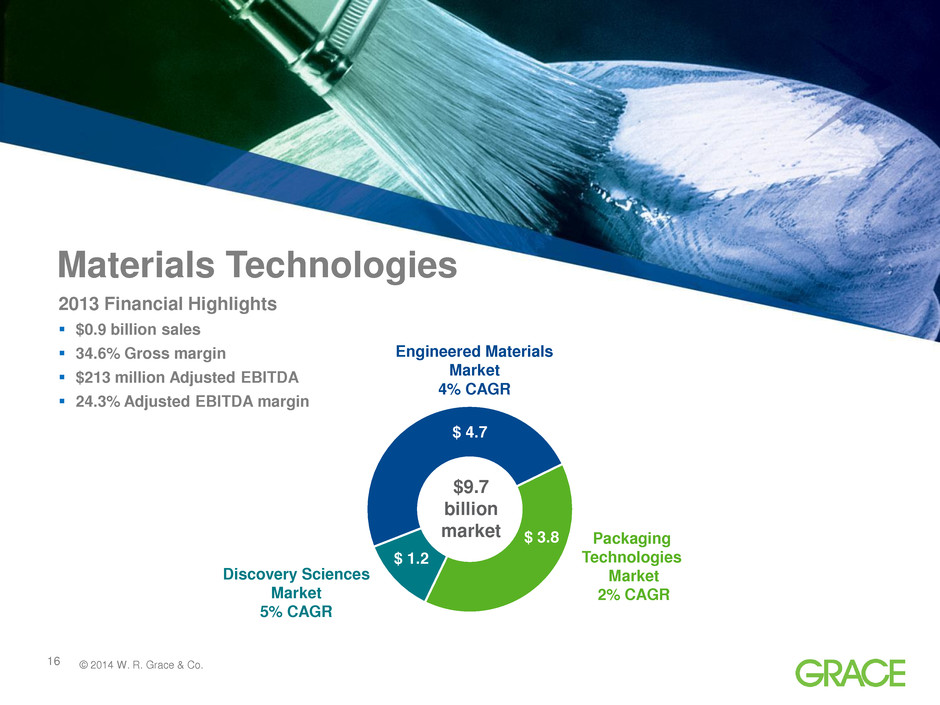
16 © 2014 W. R. Grace & Co. Materials Technologies $ 3.8 $ 1.2 $ 4.7 $9.7 billion market Packaging Technologies Market 2% CAGR Discovery Sciences Market 5% CAGR Engineered Materials Market 4% CAGR 2013 Financial Highlights $0.9 billion sales 34.6% Gross margin $213 million Adjusted EBITDA 24.3% Adjusted EBITDA margin
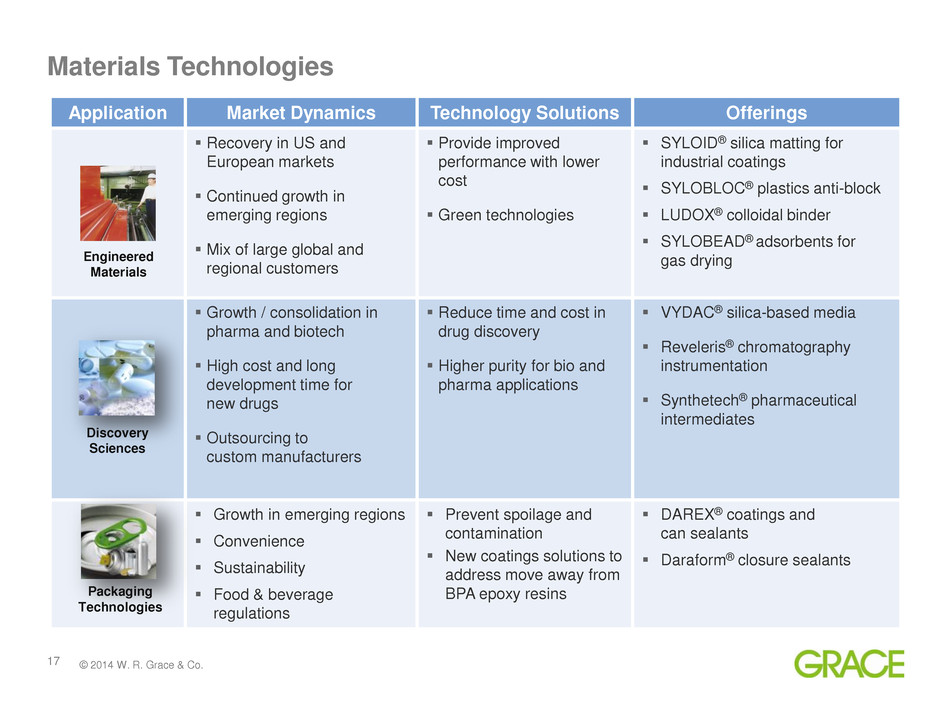
17 © 2014 W. R. Grace & Co. Materials Technologies Application Market Dynamics Technology Solutions Offerings Recovery in US and European markets Continued growth in emerging regions Mix of large global and regional customers Provide improved performance with lower cost Green technologies SYLOID® silica matting for industrial coatings SYLOBLOC® plastics anti-block LUDOX® colloidal binder SYLOBEAD® adsorbents for gas drying Growth / consolidation in pharma and biotech High cost and long development time for new drugs Outsourcing to custom manufacturers Reduce time and cost in drug discovery Higher purity for bio and pharma applications VYDAC® silica-based media Reveleris® chromatography instrumentation Synthetech® pharmaceutical intermediates Growth in emerging regions Convenience Sustainability Food & beverage regulations Prevent spoilage and contamination New coatings solutions to address move away from BPA epoxy resins DAREX® coatings and can sealants Daraform® closure sealants Discovery Sciences Engineered Materials Packaging Technologies
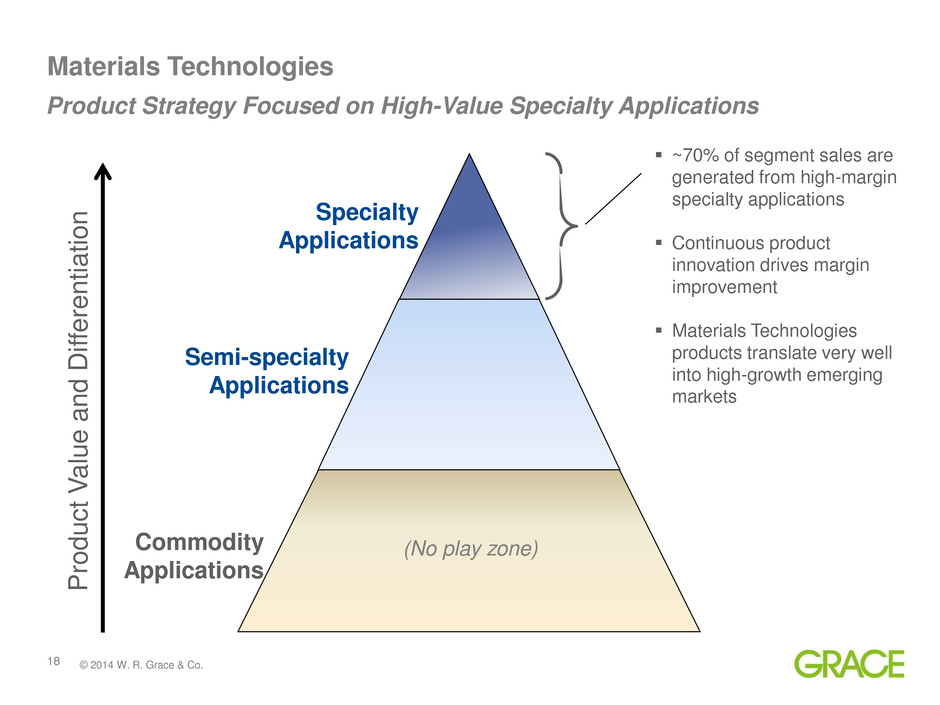
18 © 2014 W. R. Grace & Co. Specialty Applications Semi-specialty Applications Commodity Applications Produ c t V alue and Di fferentiatio n ~70% of segment sales are generated from high-margin specialty applications Continuous product innovation drives margin improvement Materials Technologies products translate very well into high-growth emerging markets Materials Technologies (No play zone) Product Strategy Focused on High-Value Specialty Applications
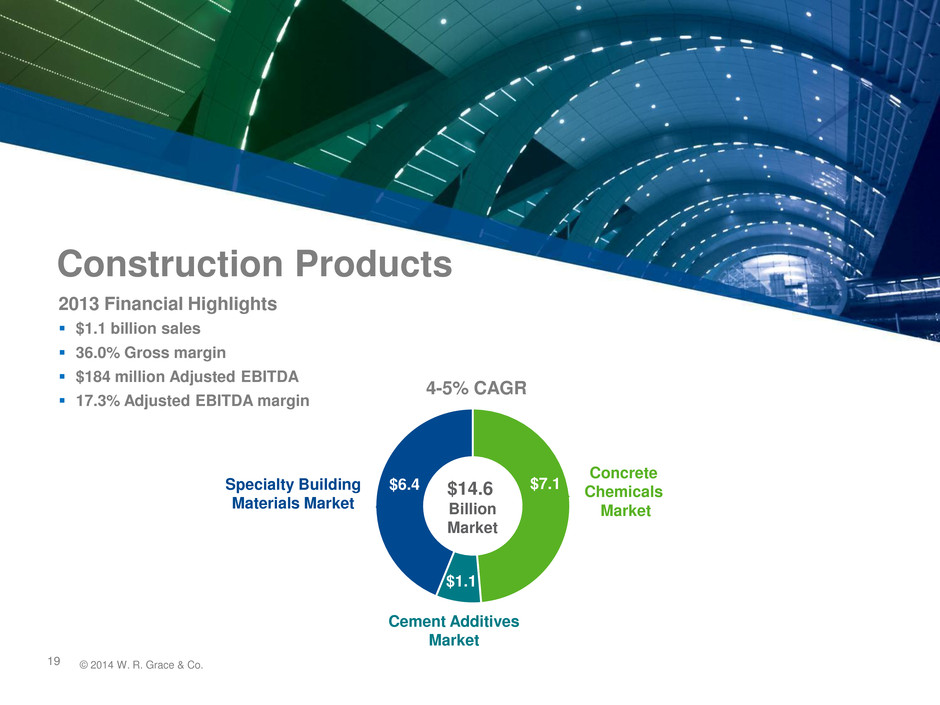
19 © 2014 W. R. Grace & Co. Construction Products $7.1 $1.1 $6.4 $14.6 Billion Market Concrete Chemicals Market Specialty Building Materials Market Cement Additives Market 4-5% CAGR 2013 Financial Highlights $1.1 billion sales 36.0% Gross margin $184 million Adjusted EBITDA 17.3% Adjusted EBITDA margin

20 © 2014 W. R. Grace & Co. Construction Materials Specialty materials, systems and services that strengthen, enhance and protect structures Business Units Market Dynamics Product Applications Offerings Mature market recovery, especially US Emerging region growth and infrastructure build-out Increasing quality of construction projects Improves cement quality Improves efficiency of the grinding process HEA2® grinding aid CBA® quality improver Improves concrete properties such as flow, placement and durability Improves performance in use Reduces labor and material costs ADVA® dispersants DCI® corrosion inhibitors STRUX® structural fibers Products for improving concrete aesthetics Provides protection to new buildings and infrastructure projects Repairs and improvements for existing buildings/ infrastructure Preprufe® commercial foundation waterproofing systems Ice & Water Shield® residential roofing underlayment systems PIERI® products for concrete aesthetics Cement Chemicals Concrete Chemicals Building Materials
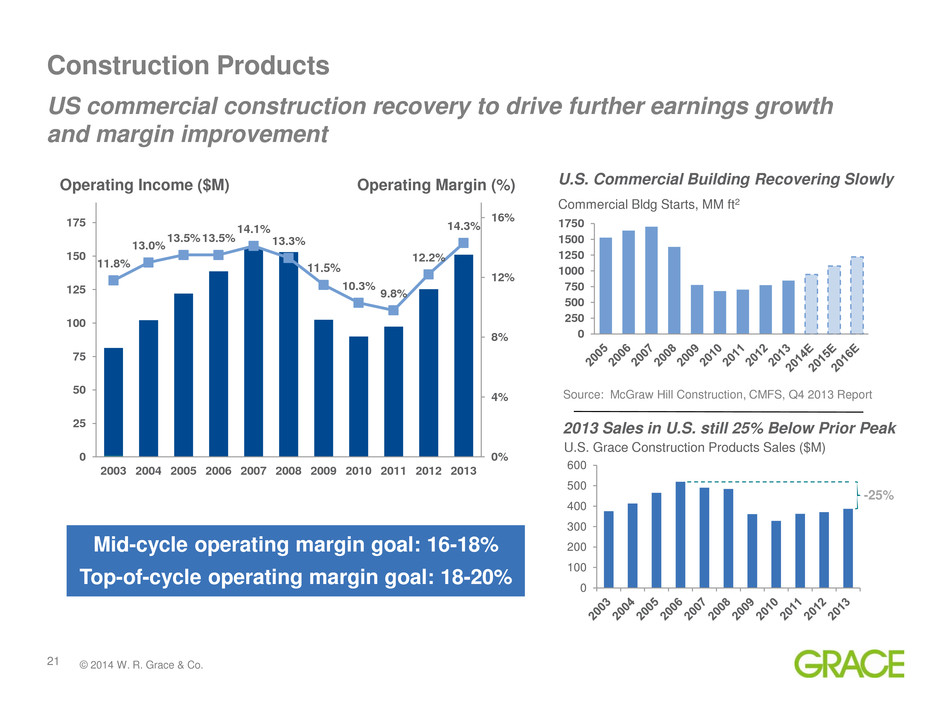
21 © 2014 W. R. Grace & Co. Construction Products 11.8% 13.0% 13.5% 13.5% 14.1% 13.3% 11.5% 10.3% 9.8% 12.2% 14.3% 0% 4% 8% 12% 16% 0 25 50 75 100 125 150 175 2003 2004 2005 2006 2007 2008 2009 2010 2011 2012 2013 Operating Income ($M) Operating Margin (%) Mid-cycle operating margin goal: 16-18% Top-of-cycle operating margin goal: 18-20% 0 250 500 750 1000 1250 1500 1750 U.S. Commercial Building Recovering Slowly Commercial Bldg Starts, MM ft2 Source: McGraw Hill Construction, CMFS, Q4 2013 Report 0 100 200 300 400 500 600 2013 Sales in U.S. still 25% Below Prior Peak U.S. Grace Construction Products Sales ($M) -25% US commercial construction recovery to drive further earnings growth and margin improvement
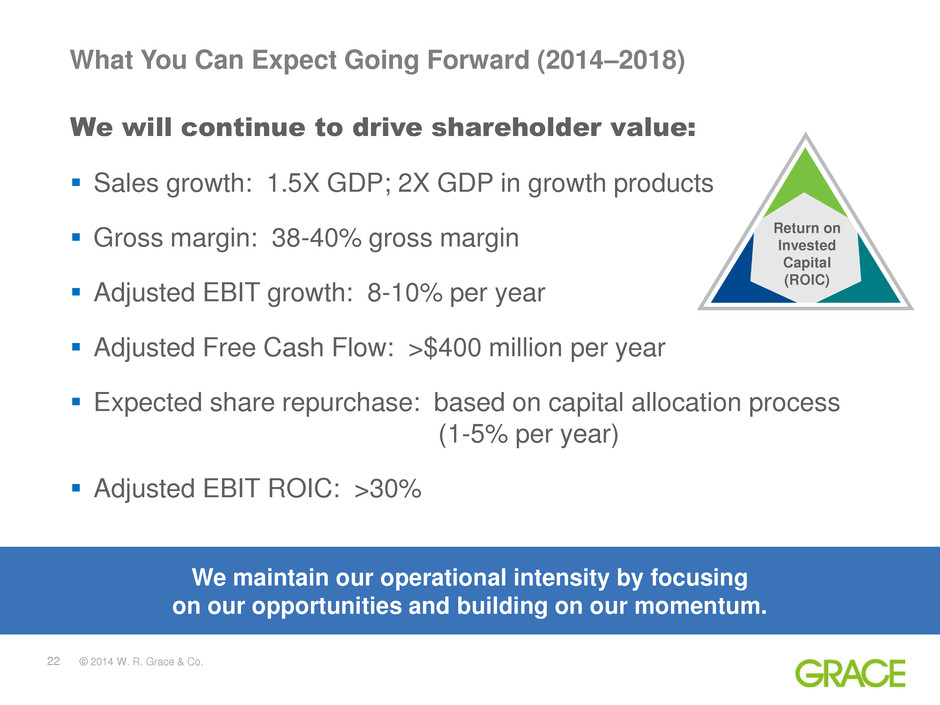
22 © 2014 W. R. Grace & Co. What You Can Expect Going Forward (2014–2018) We will continue to drive shareholder value: Sales growth: 1.5X GDP; 2X GDP in growth products Gross margin: 38-40% gross margin Adjusted EBIT growth: 8-10% per year Adjusted Free Cash Flow: >$400 million per year Expected share repurchase: based on capital allocation process (1-5% per year) Adjusted EBIT ROIC: >30% We maintain our operational intensity by focusing on our opportunities and building on our momentum. Return on Invested Capital (ROIC)
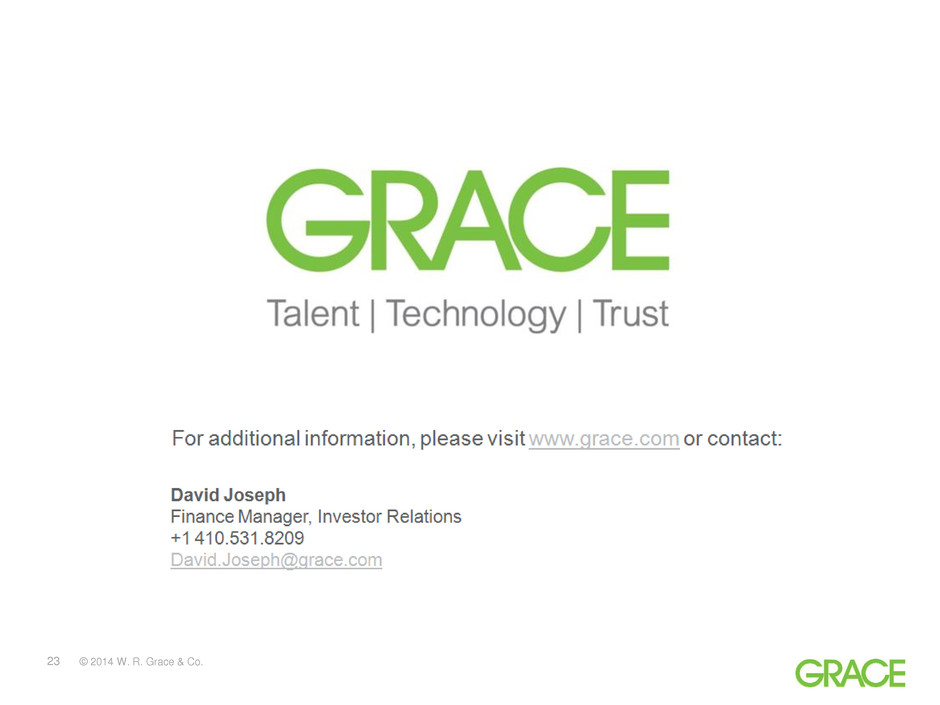
23 © 2014 W. R. Grace & Co.
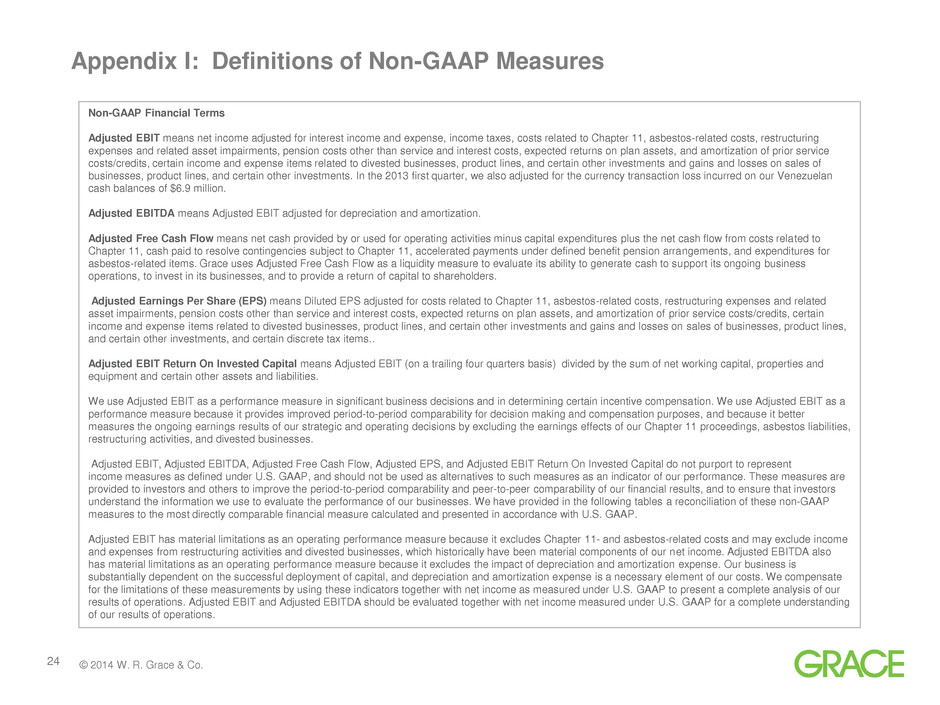
24 © 2014 W. R. Grace & Co. Appendix I: Definitions of Non-GAAP Measures Non-GAAP Financial Terms Adjusted EBIT means net income adjusted for interest income and expense, income taxes, costs related to Chapter 11, asbestos-related costs, restructuring expenses and related asset impairments, pension costs other than service and interest costs, expected returns on plan assets, and amortization of prior service costs/credits, certain income and expense items related to divested businesses, product lines, and certain other investments and gains and losses on sales of businesses, product lines, and certain other investments. In the 2013 first quarter, we also adjusted for the currency transaction loss incurred on our Venezuelan cash balances of $6.9 million. Adjusted EBITDA means Adjusted EBIT adjusted for depreciation and amortization. Adjusted Free Cash Flow means net cash provided by or used for operating activities minus capital expenditures plus the net cash flow from costs related to Chapter 11, cash paid to resolve contingencies subject to Chapter 11, accelerated payments under defined benefit pension arrangements, and expenditures for asbestos-related items. Grace uses Adjusted Free Cash Flow as a liquidity measure to evaluate its ability to generate cash to support its ongoing business operations, to invest in its businesses, and to provide a return of capital to shareholders. Adjusted Earnings Per Share (EPS) means Diluted EPS adjusted for costs related to Chapter 11, asbestos-related costs, restructuring expenses and related asset impairments, pension costs other than service and interest costs, expected returns on plan assets, and amortization of prior service costs/credits, certain income and expense items related to divested businesses, product lines, and certain other investments and gains and losses on sales of businesses, product lines, and certain other investments, and certain discrete tax items.. Adjusted EBIT Return On Invested Capital means Adjusted EBIT (on a trailing four quarters basis) divided by the sum of net working capital, properties and equipment and certain other assets and liabilities. We use Adjusted EBIT as a performance measure in significant business decisions and in determining certain incentive compensation. We use Adjusted EBIT as a performance measure because it provides improved period-to-period comparability for decision making and compensation purposes, and because it better measures the ongoing earnings results of our strategic and operating decisions by excluding the earnings effects of our Chapter 11 proceedings, asbestos liabilities, restructuring activities, and divested businesses. Adjusted EBIT, Adjusted EBITDA, Adjusted Free Cash Flow, Adjusted EPS, and Adjusted EBIT Return On Invested Capital do not purport to represent income measures as defined under U.S. GAAP, and should not be used as alternatives to such measures as an indicator of our performance. These measures are provided to investors and others to improve the period-to-period comparability and peer-to-peer comparability of our financial results, and to ensure that investors understand the information we use to evaluate the performance of our businesses. We have provided in the following tables a reconciliation of these non-GAAP measures to the most directly comparable financial measure calculated and presented in accordance with U.S. GAAP. Adjusted EBIT has material limitations as an operating performance measure because it excludes Chapter 11- and asbestos-related costs and may exclude income and expenses from restructuring activities and divested businesses, which historically have been material components of our net income. Adjusted EBITDA also has material limitations as an operating performance measure because it excludes the impact of depreciation and amortization expense. Our business is substantially dependent on the successful deployment of capital, and depreciation and amortization expense is a necessary element of our costs. We compensate for the limitations of these measurements by using these indicators together with net income as measured under U.S. GAAP to present a complete analysis of our results of operations. Adjusted EBIT and Adjusted EBITDA should be evaluated together with net income measured under U.S. GAAP for a complete understanding of our results of operations.

25 © 2014 W. R. Grace & Co. Appendix II: Implications of the PI DPO Settlement Agreement Economic Impact PI DPO settled at 9.2% discount rate compared with significantly lower financing cost Cash savings estimated at $239 million over the life of the PI DPO Earnings Impact In Q3: ~$34 million in incremental costs, primarily additional interest accretion due to the PV effect of lower interest rates since emergence Going forward: non-cash interest accretion at 9.67% replaced by cash interest expense at significantly lower rate Tax Impact Settlement payment of $632 million adds to Grace’s NOL Extends Grace’s projected low cash tax rate of 10-15% to mid-2021 Settlement agreement is a win-win Allows PI Trust to diversify their exposure to Grace and increase liquidity to pay claims Simplifies Grace capital structure at a favorable discount rate
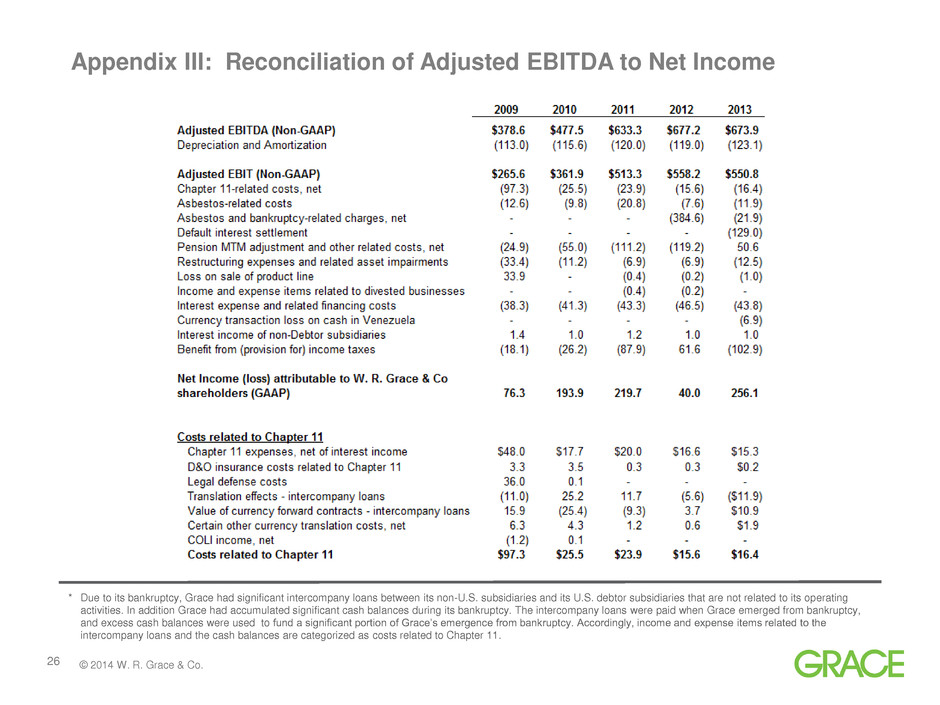
26 © 2014 W. R. Grace & Co. Appendix III: Reconciliation of Adjusted EBITDA to Net Income * Due to its bankruptcy, Grace had significant intercompany loans between its non-U.S. subsidiaries and its U.S. debtor subsidiaries that are not related to its operating activities. In addition Grace had accumulated significant cash balances during its bankruptcy. The intercompany loans were paid when Grace emerged from bankruptcy, and excess cash balances were used to fund a significant portion of Grace’s emergence from bankruptcy. Accordingly, income and expense items related to the intercompany loans and the cash balances are categorized as costs related to Chapter 11.
